eCommerce; Personalisation and Customisation
As eCommerce has continued to grow, with it, has the amount of product types being sold online. You can now buy pretty much any product, service or subscription online and it is now possible to launch a really modern, functional and stylish eCommerce website, with very little cost or skill through the likes of Shopify, WooCommerce and many others.
As such it is becoming harder and harder to differentiate your own business vs the rest of a crowded online marketplace.
This is where some businesses and brands have turned to personalisation to give them a differential. Personalisation isn’t a new concept, in fact it has been in place for many years, NIKEiD was probably one of the first iterations of a brand bringing in users to shop direct off the back of a personalisation offering, and this was launched in 1999. They offered the user the ability to choose colours, design and put their own name or slogan across some of Nikes most popular products.
While Nike don’t share their exact breakdown of Direct to Consumer Sales they do identify that NIKEiD was a key part of its overall DTC strategy, so we can only assume it has made a significant contribution to its continued growth in this channel.
Why Didn’t Everyone Do It?
While Nike were able to launch this service offer nearly 20 years ago it has taken quite a bit longer for personalisation to reach different industries and sectors. The reason being – it isn’t that easy to do from a technical standpoint and if you get it wrong then it’s a real loss making exercise.
Online shoppers expect to see exactly what they’re going to get before they add to cart so when you add this level of personalisation to a product you need to be able to render a true to life image on the screen in real time. This is easier said than done and getting it wrong could result in a lot of unhappy customers. If you give your users a choice of colour, size, font etc, these are all things that can actually look very different across different browsers, screens, devices.
It’s also something thats very unique to the product. The UX for personalising a trainer, is likely to be very different to the UX for personalising a cake for example. This means the likes of Shopify do not have an out of the box feature for this.
Beyond the actual ordering process for a personalised product, you then need to have the systems in place behind the scenes to implement the personalisation. It’s not something your ordinary fulfilment house is going to be able to offer and just like the requirement for a customised shopping UX, it’s likely you’ll require a customised backend to automate printing and ordering etc
Now we have the likes of Moonpig, Bakerdays, NotOnTheHighstreet, Historic Newspapers and many many more brands doing all kinds of personalisation and customisation of products online.
Some websites are keeping it simple, by using custom free text fields to allow users to add gift messaging, upload their own photo’s, choose colours and making small changes to the product being ordered. Some businesses have gone even further by allowing full design capabilities from a user to create a truly bespoke product.
If you are thinking about creating an e-commerce business with the backbone being personalisation or customisation then in truth, off the shelf e-commerce platforms probably aren’t the best idea. Reason being they are generally built with ‘mass market’ in mind so do a really fantastic shop of selling simple products, but trying to get them to do something they’re not designed to do, it can end up being costly and fragile.
While it may seem daunting building your own bespoke eCommerce solution, if you work with the right technical partner the rewards can be tremendous as you will have a completely customer built solution that does exactly what you want – and you own the IP, it will be ‘your’ platform, which if you have longer term goals of selling your business can also add value as an asset of the business.
Speak Soon
https://sotechnology.co.uk/contact/
Mark Purdy, Managing Director, SOtechnology

